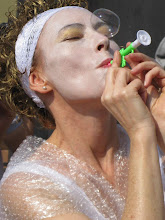
Ulsan, Korea.
The International Creative Community (I.C.C.) is a unique artist’s group founded in 2006 by Australian artist, Lainie Cooper and Ulsan-based Korean artist, Kim Chang Han. Their aim was to foster cultural exchange between artists of different countries through exhibitions, workshops and home-stay exchange programs. In June this year, 12 Australian artists visited Korea to participate in an exhibition in the prestigious Hyundai Art Gallery in Ulsan, as well as touring around Korea and participating in a variety of art seminars and workshops. During this time I met one of the visiting Australian artists and viewed the exhibition, and subsequently joined the group myself.
Membership of the I.C.C. is not limited only to Australians like myself, or Koreans – in fact there are also members from Canada, U.S.A., and England, and the ICC welcomes any emerging or established artists of any nationality to join as new members. This month, from December 11 - 20, the ICC is holding another international exhibition in the Bukgu Culture and Arts Center in Ulsan. The exhibition title is “Impressions from Afar – A Visitor’s Perspective”, reflecting the way that foreigners often view a new country with fresh eyes. Hence, the Korean artists are sharing artworks inspired by their overseas travels, with many interesting visions of foreign lands such as Africa, China, Australia, India and Europe, and the foreign artists are showing work based on their varied impressions of Korea.
Unlike the June ICC exhibition, when most of the foreign artworks were contributed by the visiting Australian artists, this time many of the foreign artists represented are actually resident here in Korea, which adds quite a different dimension. There are 3 foreign resident photographers – Kevin Pope, Katrina Baran and Kevin Copley showing their unique vision of the Korean people and landscape, as well as multi-media artist, Ryan Maclay displaying an installation inspired by the distinctive graphics and design features of Korean clothing. Other resident artists include Canadian painter David Macri, with his commemorative portrait of an uncle who died in the Korean War, and Australian painter/ writer Leah Broadby with some autobiographical works. Also included are paintings and ceramics sent over by some of the Aussie exchange artists inspired by their Korean visit in June 2007.

Of course I contributed to this exhibition as well, with last night’s opening performance entitled “Portrait of a Foreign Artist in Korea, 2007”, and an installation of the same name. During one part of my performance I actually emerged from a zipped up suitcase and proceeded to give an English lesson on the theme of ‘time is money’ (an action which should be readily understood by many a foreign teacher in Korea).
The I.C.C. ‘Impressions from Afar’ exhibition will run until Thursday December 20, 2007 at the Ulsan Bukgu Culture & Arts Center gallery, 1010, Saneop-ro, Bukgu, Ulsan. You can contact the Gallery on 052-219-7400, or for enquiries in English about the exhibition or ICC membership please contact Kim Chang han on 018 591-3338, or email: kchn@use.go.kr.
______________________________________________________
The author of this blog, Penelope Thompson, is an Australian contemporary artist living in Korea who works in performance, installation and community art events. You can see her personal exhibition blog at penelopethompson.blogspot.com.

.jpg)




